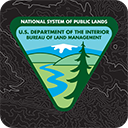Public lands are responsive to the increased demand for renewable energy
By Derrick Henry, Public Affairs Specialist
Significant portions of BLM public lands have excellent solar, wind and geothermal energy potential, and the BLM works to provide proper siting for environmentally sound development of renewable energy on public lands. This is an unbeatable combination for companies looking to unlock the energy from the sun, wind, and geothermal heat. In fiscal year 2021, renewable energy projects generated $4.4 billion in economic output across the nation.
According to the BLM’s latest Sound Investment brochure, in fiscal year 2021 there were 47 operating geothermal power plants with federal interest that have an installed capacity of approximately 2,500 megawatts and an average capacity factor of more than 70 percent. Average capacity factor means the ratio of actual output to maximum possible output. Through fiscal year 2021, the BLM approved 38 solar energy projects with a generation capacity of more than 7,110 megawatts and 36 wind energy projects with a generation capacity of more than 3,000 megawatts.
Our brochure specifically highlights renewable energy projects in two states, Arizona and Nevada.
In Arizona, the BLM there approved an amendment request for a right-of-way for a solar energy project that will add battery storage to planned solar energy infrastructure. This project is expected to produce 260 megawatts of electricity and 260 megawatts of energy storage — enough to power 91,000 homes. In Nevada, the BLM approved permits for utility-scale renewable energy projects that include 29 geothermal, 1 wind, and 12 solar energy projects with a total combined capacity of 3,277 megawatts.
These project approvals support the goal of a carbon pollution-free power sector by 2035, as well as Congress’s direction to permit 25,000 megawatts of solar, wind, and geothermal energy production on public lands no later than 2025.
Before permits are issued, renewable energy projects undergo extensive review. The BLM issues rights-of-way grants and leases under the Federal Land Policy and Management Act for solar and wind energy and for transmission lines that support renewable energy projects. For geothermal projects, we authorize those projects in phases, under the Geothermal Steam Act.
You can learn more about the BLM’s economic contributions from renewable energy and more, including by state, at the Sound Investment 2022 brochure’s webpage.
BLM employees take government policy and turn it into real work on the ground. This article is based on information from the BLM’s 2022 Sound Investment brochure. The brochure, which uses fiscal year 2021 data, highlights the various activities that take place on public lands, and their contributions to the national economy. In fiscal year 2021, authorized use and management of BLM-administered lands supported $201 billion in economic output and nearly 783,000 jobs across the country.
